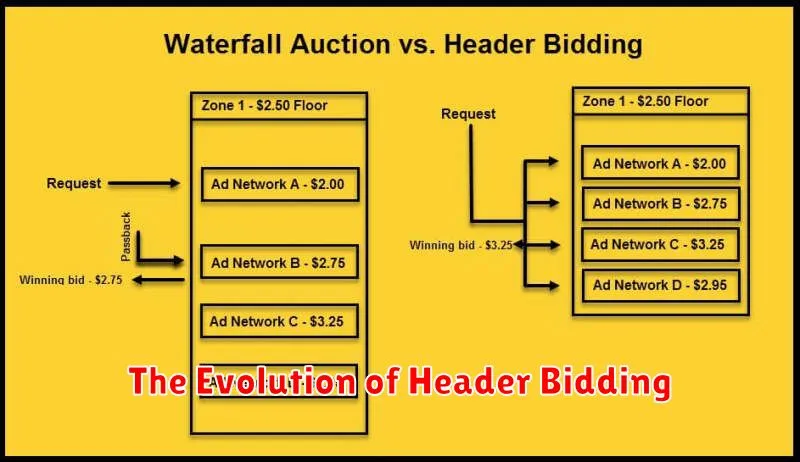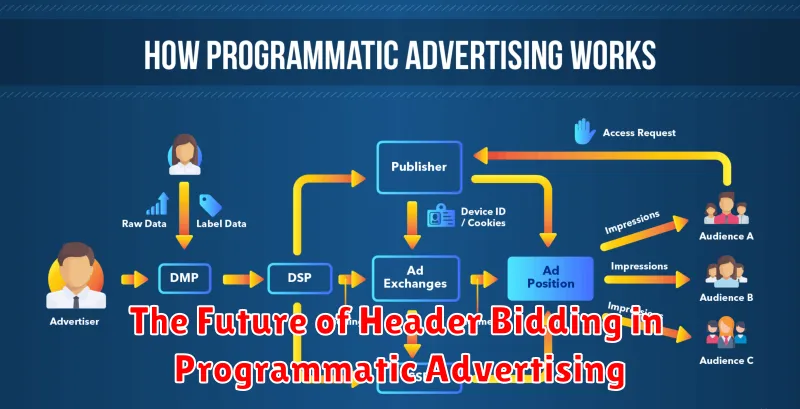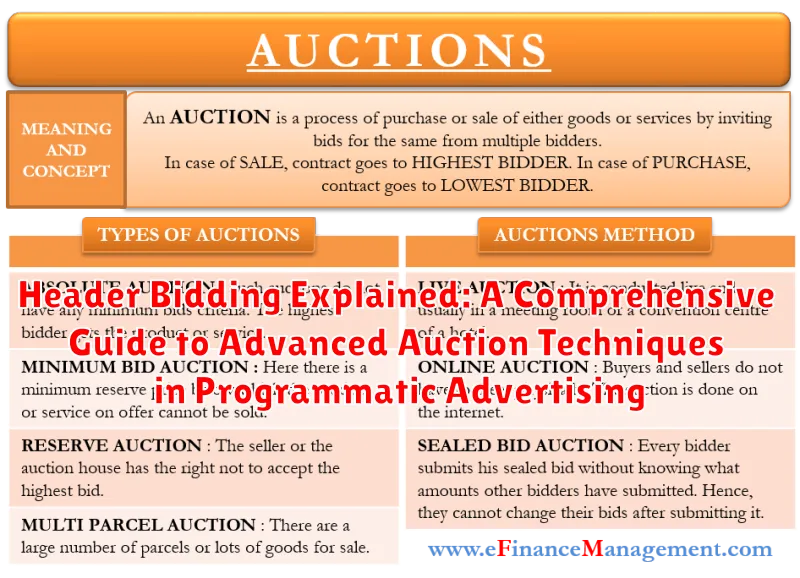In the rapidly evolving landscape of programmatic advertising, publishers and advertisers are constantly seeking innovative strategies to maximize revenue and optimize ad yield. One such technique that has gained significant traction is header bidding. This sophisticated auction method represents a paradigm shift from the traditional waterfall approach, offering a more transparent and competitive environment for selling ad inventory. Our comprehensive guide, “Header Bidding Explained: A Comprehensive Guide to Advanced Auction Techniques in Programmatic Advertising,” delves into the intricacies of header bidding, providing a detailed overview of its benefits, implementation strategies, and potential challenges.
This article is designed to equip you with the knowledge and insights necessary to understand and leverage header bidding effectively. We will explore the fundamental principles behind advanced auction techniques, comparing them to traditional methods, and highlighting how header bidding can lead to increased revenue for publishers and improved ROI for advertisers. Whether you are a seasoned programmatic advertising professional or new to the concept, this guide will serve as an invaluable resource in navigating the complexities of the modern advertising ecosystem. Prepare to unlock the full potential of your advertising campaigns through a deeper understanding of header bidding.
What is Header Bidding?
Header bidding, also known as pre-bidding or advance bidding, is a programmatic advertising technique that allows publishers to offer their ad inventory to multiple ad exchanges and supply-side platforms (SSPs) simultaneously before making calls to their ad server.
In traditional waterfall setups, ad inventory was offered sequentially to ad exchanges, with each exchange having the opportunity to fill the impression before moving on to the next. This often resulted in missed revenue opportunities as lower-paying exchanges might have been prioritized over higher-paying ones.
Header bidding addresses this inefficiency by creating a real-time auction in the browser’s header, where multiple demand partners can bid on the same impression at the same time. The highest bid wins and is then passed to the ad server for final decisioning and ad delivery. This increases competition for ad inventory and helps publishers maximize revenue.
How Does Header Bidding Work?
Header bidding, also known as advance bidding or pre-bidding, revolutionizes the programmatic advertising landscape by allowing publishers to offer their inventory to multiple ad exchanges simultaneously. This contrasts with the traditional waterfall method, where ad requests are passed sequentially to ad networks.
Here’s a simplified breakdown of the process:
- User Visit: A user visits a website containing header bidding code.
- Bid Requests: The header bidding code sends bid requests to multiple ad exchanges and Supply-Side Platforms (SSPs) simultaneously.
- Bids Received: These platforms evaluate the ad impression based on available user data and return their bids.
- Auction: The publisher’s ad server conducts an auction among all bids, including those from the direct sales team (if applicable) and selects the highest bid.
- Ad Display: The winning ad is served to the user.
This parallel auction process significantly increases competition for ad impressions, potentially leading to higher revenue for publishers.
The Evolution of Header Bidding

Header bidding emerged as a solution to the inefficiencies of the traditional waterfall method in programmatic advertising. Initially, publishers relied on a sequential process where ad inventory was offered to ad exchanges one at a time.
The limitations of the waterfall approach, such as lost revenue due to lower priority exchanges filling inventory before higher-paying ones, fueled the development of header bidding.
Early header bidding implementations were client-side, involving JavaScript code within the webpage’s header to simultaneously solicit bids from multiple demand partners. This approach, while effective in increasing revenue, introduced latency issues.
To address latency, server-side header bidding solutions emerged. This method shifts the auction process to a server, reducing the load on the user’s browser and improving page load times. Hybrid models, combining aspects of both client-side and server-side approaches, are also prevalent.
The evolution continues with advancements in header bidding technology focusing on transparency, efficiency, and more sophisticated auction dynamics.
Benefits of Header Bidding for Publishers
Header bidding offers significant advantages for publishers, primarily by enhancing revenue generation and providing greater control over their ad inventory. By allowing multiple demand partners to bid simultaneously on each impression, publishers can secure higher CPMs and increase overall ad revenue.
Key benefits include:
- Increased Revenue: Competition among bidders drives up the price for ad space.
- Improved Fill Rates: More demand translates to a greater likelihood of selling impressions.
- Transparent Demand: Publishers gain better visibility into which advertisers are bidding on their inventory and how much they are willing to pay.
- Reduced Reliance on Waterfalling: Header bidding streamlines the ad serving process, diminishing the dependency on traditional waterfall setups which can be inefficient.
- Real-Time Optimization: Publishers can leverage data and analytics to optimize their header bidding setup for maximum revenue.
Ultimately, header bidding empowers publishers to take charge of their monetization strategy and maximize the value of their ad inventory.
Benefits of Header Bidding for Advertisers
While header bidding is often lauded for its advantages to publishers, advertisers also stand to gain significantly from this advanced auction technique. By participating in header bidding auctions, advertisers gain access to premium inventory and greater transparency in the bidding process.
Enhanced Access to Inventory
Header bidding allows advertisers to bid on inventory that might have previously been reserved for direct deals or prioritized for specific ad networks. This increased access opens up opportunities to reach a wider and more targeted audience.
Improved Transparency and Control
With header bidding, advertisers can see where their bids are being placed and how they are performing in relation to other bidders. This increased transparency provides greater control over ad spend and campaign optimization. The data obtained can then be leveraged to better inform future advertising strategies.
Potential for Lower Costs
The competitive nature of header bidding can sometimes lead to lower costs for advertisers. By bidding against multiple demand sources simultaneously, advertisers can potentially secure inventory at a more favorable price point compared to traditional waterfall setups.
Challenges of Implementing Header Bidding
Implementing header bidding, while offering significant advantages, presents several challenges for publishers. These challenges can impact performance and require careful consideration and strategic planning.
Technical Complexity
One of the primary challenges is the technical complexity involved. Setting up and managing header bidding requires technical expertise, including understanding JavaScript, APIs, and ad server configurations. Publishers may need to invest in developer resources or third-party solutions.
Latency Issues
Latency is another critical concern. Adding multiple ad partners to the header bidding auction can increase page load times, potentially impacting user experience and SEO rankings. Optimizing code and server infrastructure is crucial to minimize latency.
Increased Complexity in Reporting and Analysis
Managing and analyzing data from multiple demand sources can be complex. Publishers need robust reporting and analytics tools to track performance, identify trends, and optimize their header bidding setup effectively. Standardizing data formats across partners is essential for accurate reporting.
Maintaining Relationships with Demand Partners
Building and maintaining relationships with multiple demand partners can be time-consuming and require dedicated resources. Publishers need to negotiate rates, monitor performance, and ensure compliance with their policies.
Key Header Bidding Technologies and Providers
The header bidding landscape is supported by various technologies and providers that facilitate the auction process. These technologies enable publishers to offer their inventory to multiple demand sources simultaneously.
Key Technologies
- Prebid.js: A widely used open-source header bidding framework that allows publishers to manage demand partners and configure auction settings.
- Server-Side Header Bidding: Also known as cloud-based header bidding, this approach reduces latency by moving the auction process to a server, rather than executing it within the user’s browser.
Notable Providers
Several companies offer header bidding solutions, providing publishers with the tools and support needed to implement and optimize their strategies.
- Google Ad Manager (GAM): GAM offers header bidding functionalities via its Exchange Bidding feature.
- PubMatic: A provider offering a comprehensive platform for header bidding and programmatic advertising.
- Index Exchange: Another key player providing header bidding solutions and exchange services.
Choosing the right technology and provider depends on factors such as the publisher’s size, technical capabilities, and specific revenue goals.
Best Practices for Header Bidding Implementation
Implementing header bidding effectively requires careful planning and execution. Here are some best practices to ensure optimal performance:
- Optimize Auction Timeout: Carefully configure the timeout duration to balance bid participation and page load speed. Experiment to find the ideal setting.
- Manage Bidder Density: Avoid overwhelming the auction with too many bidders. Focus on quality partners that deliver consistent value.
- Implement Granular Reporting: Track performance metrics for each bidder to identify areas for improvement and optimize bid strategies.
- A/B Test Configurations: Continuously test different settings, such as price floors and bidder priorities, to identify the most effective configurations.
- Ensure Header Bidding Code is Properly Implemented: Correct implementation prevents errors and lost revenue opportunities. Validate your implementation with tools and consult with experts.
Regularly review and adjust your header bidding setup to adapt to changes in the advertising ecosystem and maximize revenue.
The Future of Header Bidding in Programmatic Advertising

The landscape of programmatic advertising is ever-evolving, and header bidding is no exception. The future of this technology points toward increased sophistication, efficiency, and transparency.
One key trend is the continued growth of server-side header bidding. This approach reduces page latency and improves the user experience compared to client-side setups. Expect to see more publishers migrating to server-side solutions for enhanced performance.
Advanced analytics and machine learning will play a crucial role in optimizing header bidding strategies. Publishers will leverage data-driven insights to dynamically adjust bid floors, identify high-value inventory, and personalize ad experiences.
The industry is also moving towards greater standardization and interoperability. Initiatives aimed at creating a unified framework for header bidding will facilitate seamless integrations and streamline the bidding process for both publishers and advertisers.
Finally, privacy considerations will continue to shape the future of header bidding. Solutions that prioritize user privacy and comply with regulations like GDPR and CCPA will be essential for maintaining trust and sustainability in the programmatic ecosystem.

